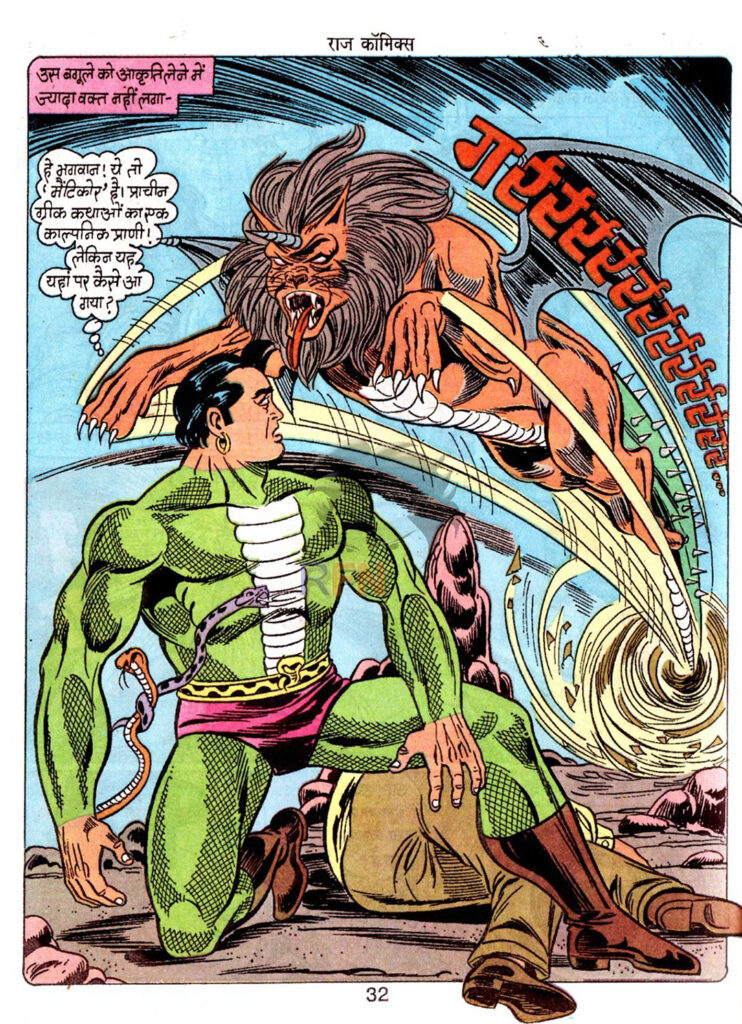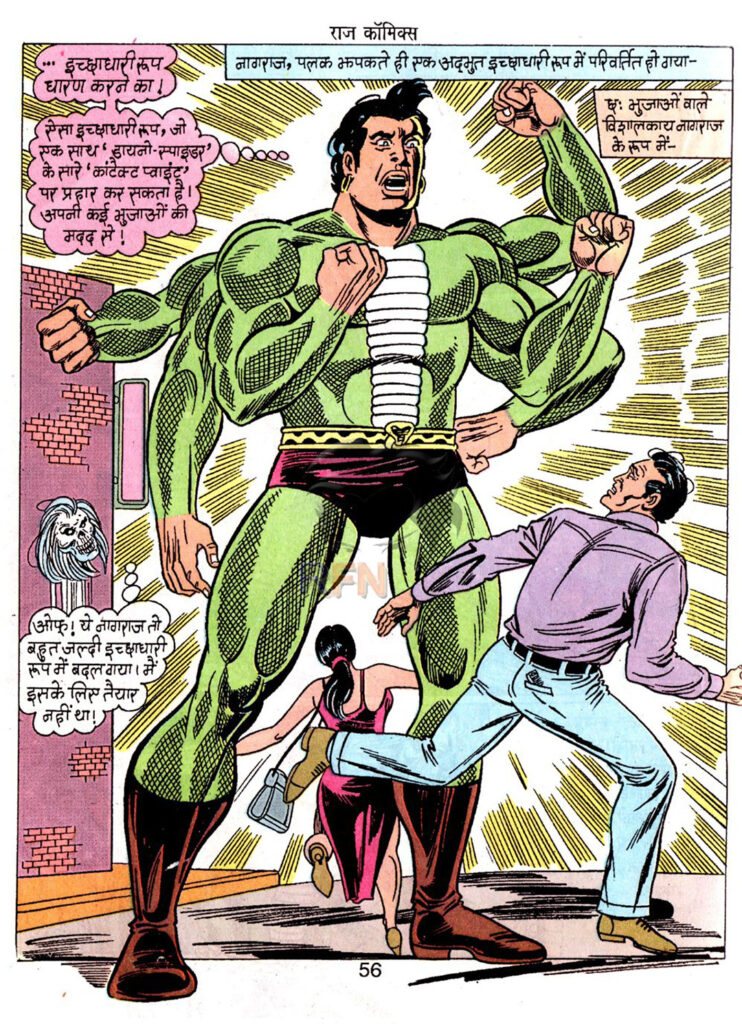Raj Comics has had a monolithic empire in the world of Indian comics, and the brightest star of this empire is undoubtedly Nagraj. From his early days till today, Nagraj has defined the concept of the Indian superhero and taken it to new heights. There are some stories in Nagraj’s long comics journey that proved to be milestones, which not only gave depth to his character but also left an indelible mark on the minds of readers. One of these stories is ‘Ichchadhari’. Written and illustrated by Anupam Sinha, the comic focuses on the most mysterious and powerful aspect of Nagraj — his willful power. This story is not just another exciting adventure, but an excellent depiction of Nagraj’s internal struggles, his moral limitations, and his greatness as a hero.
Analysis of the story
The story of Ichchadhari begins with a TV interview, where journalist Bharti is telling the general public about the powers of Nagraj. This opening scene lays the foundation of the story, where Nagraj displays his various powers such as poison-whipping, serpent-army, and Nagar-Rassi. But when Bharti mentions his most powerful ‘wishful’ power, Nagraj’s face fills with tension and he hesitates to talk about the topic. His behavior attracts the attention of a mysterious, invisible observer who is watching this interview from somewhere far away. This observer, who calls himself See Through, is a bodiless soul or energy that needs this same willful power of Nagraj to regain its physical body.

This is where the main conflict of the story begins. The villain’s plan is simple but effective: to put Nagraj in a dire situation where he is left with no other option but to break his oath and exercise his willful power. For this, he gets Bharti and her team kidnapped by local tribes in a remote, rocky area called the Old City. Knowing that Bharti’s life is in danger, Nagraj immediately reaches the Old City. He easily vanquishes the people of the clan, but soon discovers that these people were mere pawns.
The real danger comes when the villain unleashes his true weapon — a giant, winged prehistoric creature — against Nagraj. This creature is physically extremely powerful and almost invincible. Here begins the best action sequence of the comic. Nagraj fights the demon with all his might, but all his powers prove to be dwarfed in front of that creature. His venom, his serpent-army, and his physical strength — everything fails. The villain constantly taunts Nagraj, provoking him to use his ultimate power.
This part of the story reveals the depth of Nagraj’s character. Readers become curious to know why Nagraj has sworn not to use such a powerful ability. The comic takes us to a brief but moving flashback, where it is revealed that this power came to him as a boon from a divine serpent god. This power is meant only to protect creation, not for any personal gain or violence. Misusing it can corrupt both this power and the user, turning Nagraj into a destructive force. This knowledge places a heavy burden on Nagraj’s shoulders and increases his inner duality.

At the climax, when Nagraj is on the verge of defeat and See Through has almost killed him, his self-control and morality are put to the real test. He struggles more with the mental anguish of breaking his oath than with physical pain. At the same time, the villain makes his last move and merges his energy into the demon’s body so that he can deliver the final blow to Nagraj. But Nagraj, using his extraordinary intelligence and willpower, finds a different path. He does not exercise his willful power directly, but instead unleashes an intense burst of his inner energy that directly strikes See Through’s brain and frees him from the villain’s control.
Art and portraiture
Anupam Sinha’s art is the soul of this comic. His portraiture is as dynamic, detailed, and soulful as ever. Each panel is very finely made. The portrayal of Nagraj’s character is impressive — his muscular physique, the look of firmness on his face, and his agility in the action sequences — everything seems alive. The design of the villain See Through, especially his skull-like face, is sinister and memorable. The depiction of the prehistoric giant is also spectacular; its huge wings, fangs, and powerful body evoke fear in the reader’s mind.

The combination of action sequences is excellent. The panels of the battle between Nagraj and the demon infuse a rapid pace and energy into the story. Vitthal Kamble’s inking further enhances Sinha’s pencil work, bringing clarity and depth to the lines. The use of colors plays an important role in establishing the mood of the story. Brown and dark shades have been used for the stony, desolate landscape of the Old City, creating a mysterious and dangerous atmosphere, while the use of bright colors in the TV studio scenes reflects a modern and public setting. Overall, the artwork of Ichchadhari is a great example of the golden age of Raj Comics.
Characterization
The biggest strength of this comic is its characterization, especially of Nagraj. The story elevates Nagraj from a simple ‘killing’ superhero to a complex and thoughtful character. Here we see a Nagraj who is not only physically but also mentally and morally strong. His decision not to use his greatest power is a powerful example of the principle that ‘with great power comes great responsibility’. His inner struggle connects readers to him on an emotional level.
The villain See Through is also a memorable character. He is cunning, sly, and focused on his goal. His being bodiless makes him an irresistible threat, as he does not attack directly but instead makes others his puppets. His motivation — the desire to have a body — also keeps him from being a one-dimensional villain.
Bharti’s character acts as an important catalyst in taking the story forward. Although she plays the role of a ‘heroine in distress’, she also emerges as a trusted friend and confidant of Nagraj, through whom readers get insights into Nagraj’s world.
Conclusion
Nagraj – Ichchadhari holds its place as a classic story in the history of Indian comics. It’s not just an action-packed comic, but also a deep reflection on the themes of power, responsibility, self-control, and morality. Anupam Sinha’s entertaining story and brilliant art together have created an experience that is as impressive today as it was at the time of its publication. This added a new dimension to the character of Nagraj and further enriched his mythology. This comic is proof that Indian superhero stories can be as deep and thought-provoking as Western comics. It’s a must-read for every comics fan, whether old or new. Ichchadhari is not just a story, but an important chapter in Nagraj’s journey that defines him as a hero.
